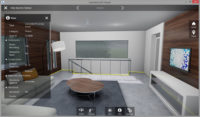Virtual reality, or VR, has had many lives. Expensive and clunky, VR, whose goal is creating an immersive spatial experience from data, never gained a foothold outside of academia, the military, or specialized industries. However, in the past few years, VR has reemerged as a way of developing and exploring proposed environments by architects, builders, and clients.
Today’s VR is comprised of three fundamental elements that can be traced back to flight-simulator research from the late 1960s: a virtual environment, a prop to affect that environment, and a digital display to view it, says Jeff Jacobson, CEO of ConstructionVR. He adds that, in its current incarnation, VR combines hardware advances spurred by smartphones with the software developments of the gaming industry, making it an accessible and surprisingly practical platform for design practice.
Increasingly, architects are playing a significant role in shaping VR. SHoP has been working closely with software developers, including New York–based IrisVR. The architecture firm has used Iris applications on a number of projects, including its expansion of the Site Santa Fe Contemporary Arts Center, slated to be completed in late 2017, employing it both as a design tool and a way to introduce the scheme to museum visitors through an immersive exhibition.
For the Santa Fe project, SHoP used Iris’s two offerings, which span the dominant modes of consumer-oriented VR. Scope is a mobile app that works with a smartphone in conjunction with an inexpensive stereoscopic viewer, such as Google Cardboard; it produces mainly static yet portable experiences. The more immersive and interactive Prospect relies on dedicated VR headsets; those have motion-enabled controllers such as Oculus Rift or HTC Vive.
Both modes of VR allow an immediate spatial understanding of environments. This is an advantage for architects when working with consultants and clients with different levels of experience reading two-dimensional drawings. But it can also enhance designers’ comprehension of the spaces they create. “It reveals, even to experts, things they did not realize about their project,” says Joel Pennington, Autodesk product manager. Autodesk’s LIVE 360, released in July, is geared to quick production directly from Revit models in only a few steps. It also allows individuals to move through virtual models as they choose.
Rather than developing stand-alone applications, other software companies, such as Vectorworks, are embedding VR capabilities in their core platforms. Its 2017 release includes a one-step 3-D-model-to-VR feature that includes an option to navigate through a space by moving the smartphone, and a “mono” mode which can be used with a tablet.
Some architects are authoring their own VR applications, including Gensler. While the firm uses a number of commercially available design technologies, it developed its own app, which runs on a smartphone and uses Google Cardboard goggles, to offer a custom VR experience to its clients and designers.
VR, however, is just one aspect of virtualization, a term used to describe the spatial presentation of digitized information. Augmented reality (AR), created by layering virtual images on top of real-world views, combines hypothetical spaces with physically existing ones. ShoP is using AR on New York’s Intrepid Sea, Air & Space Museum to record existing conditions, test design proposals, and create new experiences for visitors. A number of AR platforms are on the horizon, including Microsoft’s HoloLens, and Google’s Tango.
Virtualization can also include non-visual information, says Matthew Krissel, a partner at KieranTimberlake. The Philadelphia-based practice has developed its own sensor network, Pointelist, which allows designers to import data such as humidity, temperature, and light levels into a virtual environment and visually display it. The firm is experimenting with Pointelist on several projects, including its own office, where it is assessing environmental conditions and rethinking the way it operates in that space.
NBBJ, meanwhile, is involved with VR startup Visual Vocal. Its Web and mobile app combines optical virtual reality with voice recording, providing clients and designers a way to communicate notes, thoughts, or technical information in a virtual environment. The Visual Vocal team is working out of NBBJ’s Seattle offices and beta-testing software with the firm’s client base.
Virtualization is seen by many as essential to the practice of architecture. But as the technology moves forward and brings together different types of information from a variety of sources into a common spatial experience, it won’t be hardware and software designers setting the path of development. Instead, it will be users such as industrial designers, filmmakers, and of course architects. As ConstructionVR’s Jacobson notes, “It’s the artists who are going to change VR.”









